Before February, when the excavators came, Raleigh was home to a vibrant skate park.
Known as Graveside DIY, the park fostered a diverse community of skateboarders who raised thousands of dollars to pay for ramps that they built themselves. Local skaters likened the park—a concrete-and-asphalt expanse, surrounded by evergreen trees and tucked along a side street just south of Tryon Road—to a community garden, a second home, a place to freely fail. At Graveside, there was stacking and mortaring, carpentry and pouring. There was heel flipping and frontside grinding. There was hanging and grilling and general carousing.
“Just loud music, people tailgating every single day, cooking food every day,” recalls Aaron Collins, who runs the Graveside DIY Instagram account and helped build many of its ramps. “We’d go out there in the morning and stay all day long. We’d have bands play out there, stay the night there …. A city skate park is more for, like, a two-hour visit. But a place like that, you spend your life there.”
On New Year’s Eve, the southwest Raleigh property—just over 13 acres in total located on Mid Pines Road—changed hands. North Carolina–based Blue Heel Development bought the parcel from the Islamic Association of Raleigh for $1.25 million and, in the third-fastest growing housing market in the nation, has plans for a new residential community. Eventually, more than a dozen townhomes will line the site of the space that’s now rubble, part of a 57-unit subdivision.
With its remote-feeling, picturesque situation on private property, Graveside DIY was too good to last, the skaters knew. But, they say, you can’t kill an idea. They’re looking for a new DIY space to recapture some of the magic.
The skaters have taken a request to the Raleigh City Council to help them find underutilized public land. A cast-off private lot would work, too, as long as they could make it theirs. They know how to build it out and can get their own insurance.
“I’m just asking for permission,” says Collins. “Like a slab of concrete, like even a corner of the woods somewhere, we can make that work. All we want is permission.”
On a warm, windy afternoon at the end of March, the air yellow with pollen, the former Graveside site is serene. A bent metal patio heater, the kind you see outside of bars, stands at one end of the gravel open field; a pile of stacked, felled pine trees lies at the other.
While trespassing, I have the feeling of being the only person around for miles, though single-family homes are in my sight line and I hear traffic noise drifting up from Tryon Road over the sound of chirping birds. Facing away from the street, to the left of what was once the skate park, Miery Creek, filled with tadpoles, traverses a sliver of forest. To the right, up a little hill, an old family cemetery sunken into a forested ridge borders a sprawling green agricultural field that belongs to NC State University.
The cemetery belongs to Raleigh LaRoche III, according to Wake County property records, but it has long been a resting place for members of John Winters’s family. LaRoche is a descendant of Winters, a Raleigh businessman and developer, civil rights leader, Raleigh’s first Black city council member and one of North Carolina’s first Black state senators. Many of the graves are marked only with small signs or metal plaques, but a few larger gravestones bear names: Annie U. Kendrick, 1890–1963; Alphonso Rogers, 1884–1921; and Richard, who died at age six on Christmas Day 1922.
Graveside DIY started as a closely guarded secret back in 2016, Collins told me on a phone call a few weeks earlier. A group of older skaters “started building stuff there,” he says, “and if they caught you there, they’d make you leave. They wouldn’t let you film.” The Islamic Association of Raleigh was holding the land for eventual building or long-term investment, a spokesperson told the INDY, and likely wasn’t aware of the skaters’ use of the property until it was ready to sell. Occasionally, a cop would come by and ask some skaters to leave, Collins says, but there was no serious enforcement.
Eventually, word got out. The site became a free-for-all during the pandemic years, and “just kind of got overrun with, like, the second generation. Which is us, the younger guys, and then we just, like, full on went crazy and built a skate park there,” Collins says.
GoFundMes had historically paid for Graveside projects but at some point started seeing diminishing returns. Collins suggests I call his friend Jonathan Robbins, aka JRob, who was in charge of raising the money to pay for all the materials the skate park’s architects needed to build.
“Think of him [JRob] as a failed accountant,” Collins wrote in a text message. “He’s not very smart, but he certainly can tell a great story.”
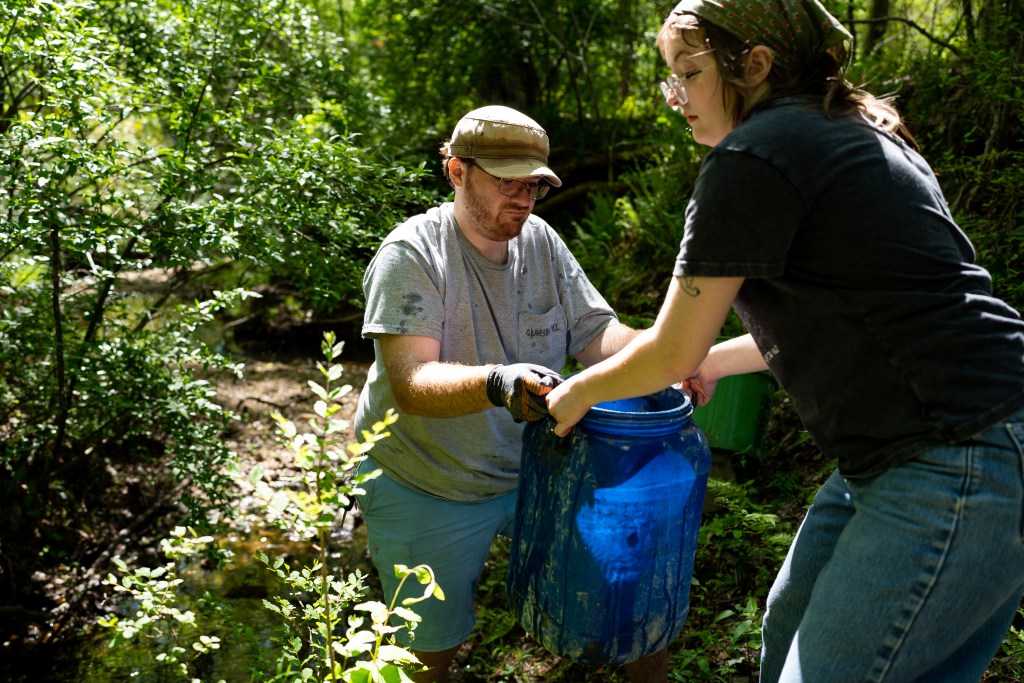
When we speak, it’s clear that JRob is neither failed nor lacking in smarts. In June 2022, he started selling Graveside-branded merchandise—T-shirts, hoodies, and skateboards—and raised nearly $18,000.
“It was like six or seven graphics, so the different homies that were, like, involved with the space did a graphic for it,” JRob says. “And so, like, all the money we raised on the merch went to the spot.”
Everyone gave a little, JRob says, and they used the money to build the entire park and maintain it. They bought cinder blocks, mortar, concrete, two-by-fours, and plywood, plus the tools they needed to build ramps—drill bits, screws, shovels, brooms, a concrete mixer. They bought paint, epoxy, lacquer, and trash bags to maintain the concrete coping, which breaks down over time.
“Concrete coping offers a better grind, so we kept up the maintenance rather than say steel coping,” JRob wrote in an email. He sent me a spreadsheet that showed the costs broken down for Graveside’s dozen or so obstacles. “I guess it shows we went the extra mile to create a better park.”
One of the products of the skaters’ builds was the punk wall, a ramp over six feet tall that was built in 2022. JRob estimates it to have cost $900–$1,200. Another, built in 2023, was the rainbow coping quarter pipe; it cost around $500 to build. Also in 2023, the skaters built the loop, one of Graveside’s most memorable projects, out of concrete held in place with wood to dry. At a cost of just over $1,000, it was one of the only loops at a DIY skate park in the Southeast, and initially, the skaters weren’t even sure if it would be skateable.
But it was.
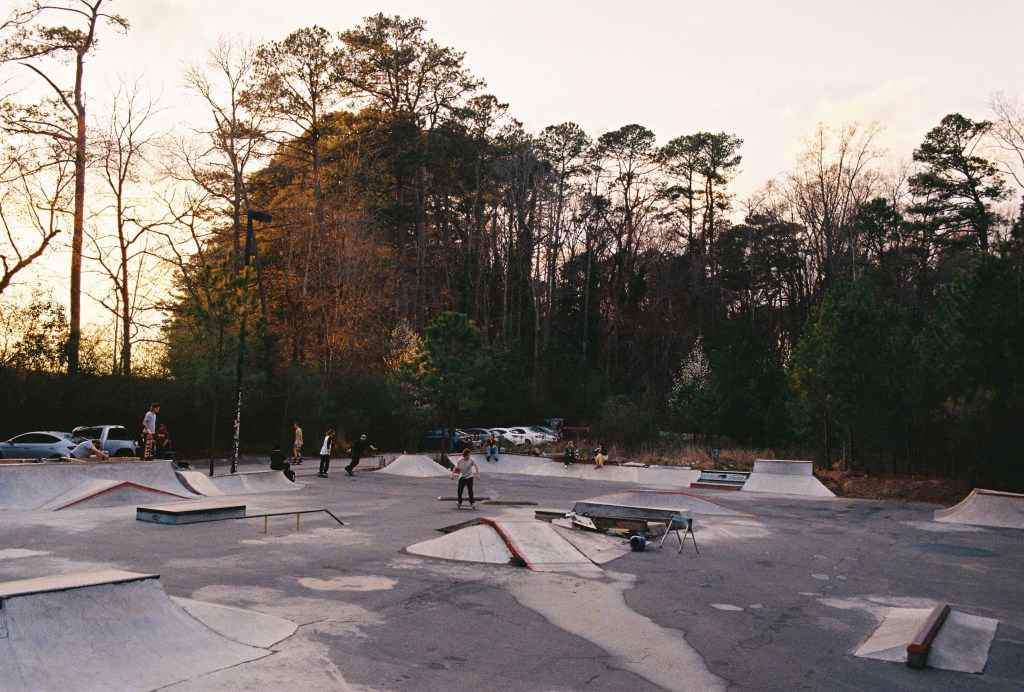
It’s a Saturday afternoon in mid-March and some of the Graveside crew are pouring concrete at the Conlon Family Skate Park, a $300,000 temporary space located along Capital Boulevard on the edge of downtown, familiarly known as Skate Raleigh. Against a backdrop of reggae music and harsh sunlight, skaters are building a small ramp. First, you stack a wall with cinder blocks and mortar, JRob had explained in his email, then you create a form from wood and pour in concrete.
I ask some of the crew about their memories from Graveside DIY, how it differed from a city-sanctioned skate park like this one.
“It’s just a lot more involved,” says Nate Mott. “It’s like, if you were to make yourself and your friends dinner or something. It’s more meaningful than, like, going out … somewhere. Like, you build it, you make the dinner all together.”
Mott and Collins reminisce about the “first annual shit-throwing competition,” with games such as Bucket in a Tree (throw a bucket into a tree and when it lands, throw things to knock it down again) and Shoes on a Light Pole (largely self-explanatory), and the natural culmination and amalgamation of these two games into one known as Shoes in a Tree.
“Very thought-out, intellectual-style games,” Collins observes.
Izzy Sweere, also at Skate Raleigh today, has known some of her Graveside friends for more than a decade, she says, from when they all lived close on Brent Road, and then Lundy Drive, and hung out together. Sweere would take her dog to Graveside, where the dog could roam around off leash. Sweere met her boyfriend at Graveside DIY.
“I loved every minute out there,” she says. “It was cool because we didn’t have to, like, text each other to hang out. I just knew everyone was gonna be there.”
Places like that are rare these days, I say. Sweere agrees.
“The only other places like that that I’ve experienced are, like, bars,” she says. “It’s a place you can actually, like, do an activity and hang out a little.”
The crew had caught wind of the upcoming development about two years ago, and followed the developer’s proposed plan for the property on its journey through the city’s bureaucratic machinery.
“I’m surprised it took as long, because it’s such a good location for, like, any, like, development,” says Sweere, noting the spot is located two minutes from I-40, 10 minutes from downtown, five minutes from NC State. “But we were there for a long time, and it ran its course perfectly.”
In mid-December, the skaters threw a farewell party for Graveside. They built a stage and a band played. Then, they destroyed the stage and the musicians destroyed their instruments.
“People came from, like, all over the place to go to the final party,” recalls JRob. “It’s like, everyone is together and having a really fun time.”
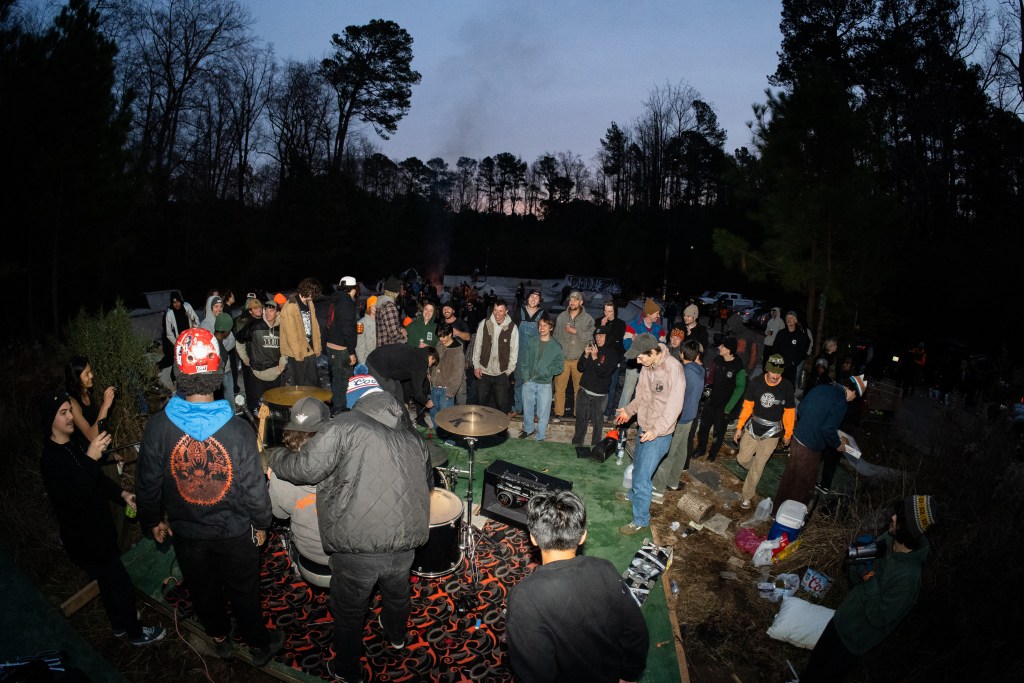
The party marked the end of an era.
On December 31, the sale of the property officially closed. Blue Heel Development paid six times more than what the Islamic Association of Raleigh had paid for the same parcel a decade ago when it purchased it from Raleigh Police Benevolent Association. The transaction was years in the making.
In the summer of 2023, Blue Heel Development submitted an application to the city to subdivide the site and annex it into Raleigh, giving any future residences on the property access to city utilities and services.
At a city Board of Adjustments meeting in January 2024, where the developer requested variances from the city’s unified development ordinance, neighbors raised concerns about flooding, water quality, and the potential for the townhomes’ sewer system to fail. The developer’s lawyer outlined a plan to provide paved street access to the old family cemetery on the site for people who visit the graveyard.
In sworn testimony before the quasi-judicial governing body, Elijah Cameron, one of the Graveside skaters, pleaded the case for the skate park.
“This park holds immense value, serving as more than just a recreational spot,” Cameron said. “It stands as a testament to our community’s resilience and unity …. It’s also the largest community park of its kind in North Carolina …. It represents our shared aspirations and dreams, a big community where diverse identities converge for a common purpose.”
On December 3, the annexation case went before the Raleigh City Council, where concerns about wastewater were raised again. The site, located in the Swift Creek Watershed, is upstream of the Yates MIll Aquatic Center, an NC State research lab that’s home to endangered species of freshwater mussels, fish, and salamanders that are reared in the water at Yates Mill County Park and released back into the wild.
An explanation of the proposed wastewater management system from the city’s water utilities staff seemed to assuage lingering concerns, and the council voted 7-1 to approve the annexation.
The bulldozers rolled up to Graveside two months later.
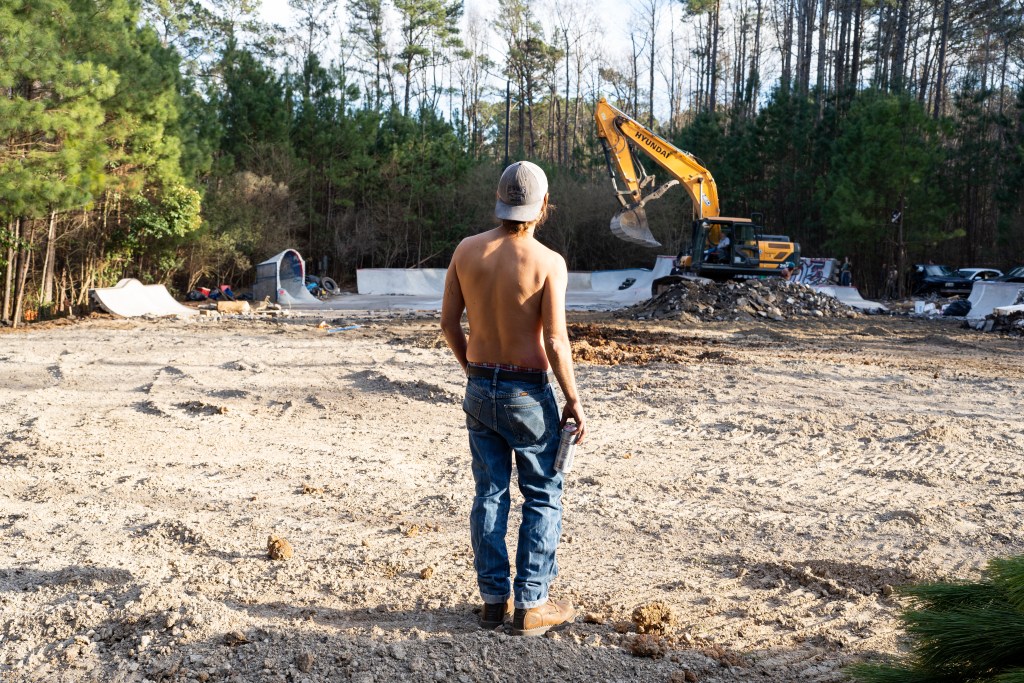
With Graveside DIY now destroyed, several of the skaters are taking their quest to find a new DIY spot to the city council chambers during evening public comment sessions. As they’ve asked the city’s leaders to help them identify new, permanent space they could use—potentially at Jaycee Park, Dix Park, or the upcoming Smoky Hollow Park—they’ve spoken about the inclusiveness of the local skating community and the lessons that come from building a community space.
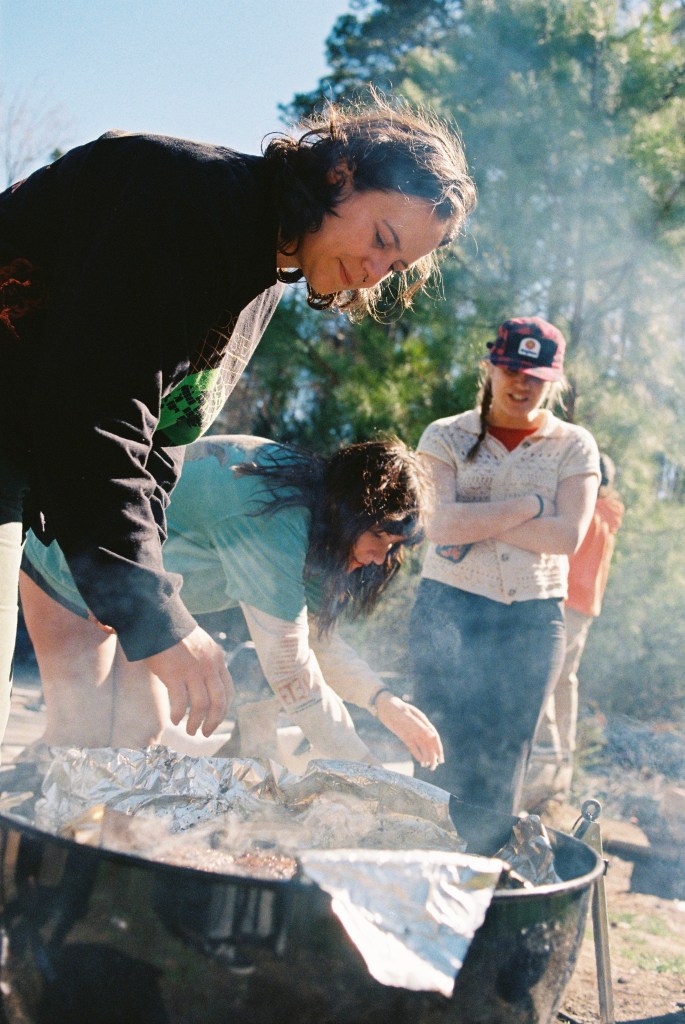
Nikki Knapp, who leads Skate Forward, a group dedicated to inclusion in skating and raising awareness around sexual violence and gender discrimination, spoke about feeling safe and comfortable to learn new tricks and practice while avoiding injury at Graveside.
“Skate Forward was born out of Graveside, the DIY,” Knapp said. “It was a place that many of us go to as women and femme skaters.”
Speaker Paul Thompson described the vitality of DIY skate spaces versus public skate parks.
“One unique characteristic of skateboarding is that the style and tricks are constantly evolving and the facilities for skateboarding need to evolve with the sport,” Thompson told the city council. “One solution to this issue is to allow skateboarders themselves to decide what features should be constructed at the dedicated space for skating.”
There are precedents, even local ones, for what the skaters are asking for. Asheville has a private DIY skate park, Foundation DIY. Both Statesville and Charlotte have DIY skate parks on public property.
In Charlotte, similar to Graveside, skaters lost their DIY spot at Eastland Mall to redevelopment. City planning and county parks and recreation staff were following their story, says Bert Lynn, Mecklenburg County’s capital planning division director, and they started working with the skaters to find a new space. The staff identified two underutilized tennis courts in a county park and looked to an existing partnership with a mountain biking group that maintained trails on county property for inspiration for how an agreement for Kilborne DIY could operate.
The county staff asked the skaters to formalize by forming a nonprofit and get insurance coverage.
“That allows them to not only utilize the space but also do some of their own construction work,” Lynn says. “They carry their insurance, and then when they’re having events, when they’re doing build days … they coordinate with our staff.”
Lynn says the Kilborne DIY arrangement has been successful. Skaters submit plans for what they want to build to the county, and the skate park operates on the same hours as the county park.
“It took a bit of time in order to find the appropriate site for them, to get the funding that they needed,” Lynn says. “And they got some donations from the city, from the county, and from some other nonprofits, as well as just donations from skaters and other folks in the community to get their 501(c)(3) funded, and then to start the fundraise to get their insurance coverage.”
You just, like, love doing it. I’ve accepted it internally that Graveside will die, and I also will someday die. You don’t want to be too attached. As much as you love the thing, nothing’s forever …. That’s why you gotta enjoy it while you got it.
Jonathan robbins, aka Jrob
At a Raleigh City Council meeting last month, city council member Megan Patton asked for more information about the skaters’ request for space. City of Raleigh staff is looking into the matter, a spokesperson told the INDY, but declined to elaborate further.
For now, the skaters have a few other places to go. There’s Marsh Creek in North Raleigh and some family skate parks in Apex and Cary. There’s a site behind Kris Kringle’s Coins near the mall.
But even some of these spaces feel like they are on borrowed time. Skate Raleigh will be demolished in two years to make way for Smoky Hollow Park. The independently owned skate shop, Endless Grind, another hub for the skaters, is tangled up in a rezoning fight over a 30-story tower (the store has been in its Peace Street location since the 1980s, says manager Miguel Magallanes; he doesn’t know when they might start looking for a new space).
There’s a moment toward the end of a 10-minute demo-documentary on YouTube from 2023 featuring some of the Graveside skaters where JRob reflects on other DIY sites that have come and gone and ponders a hypothetical time in the future when Graveside goes the same way. He has no regrets, he says, and “wouldn’t dream of giving up on pouring Graveside until the very last second.”
“You gotta live in the moment,” JRob tells the camera. “I can’t be thinking about ‘Oh, Graveside’s gonna get torn down, I should stop.’ I don’t really care. You gotta smoke ’em while you got ’em, strike while the iron’s hot. There’s not gonna be another Graveside, but there’s always going to be another DIY.”
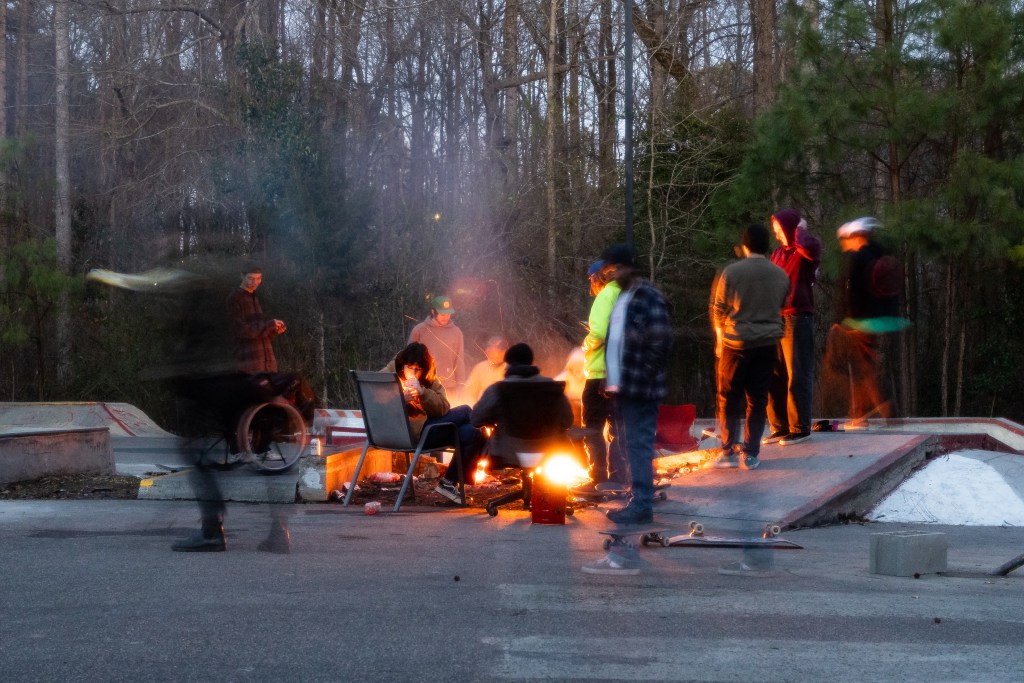
The camera cuts away to some of the others, then JRob is back musing on the screen.
“You move on to the next thing,” he continues. “You keep going. Perseverance, you gotta persevere. You just, like, love doing it. I’ve accepted it internally that Graveside will die, and I also will someday die. You don’t want to be too attached. As much as you love the thing, nothing’s forever …. That’s why you gotta enjoy it while you got it.”
This is why they’re asking the city council, or some benevolent landholding private citizen, for a plot of unused land where they can rebuild.
On that Saturday at Skate Raleigh, Jack Gordon, another of the Graveside skaters, tells me he wishes the developer would hurry up and start construction on the townhomes, “so it’s like it didn’t get torn down for nothing.”
“It would be a bummer if they didn’t start building those things until, like, next year,” he says.
But the developers haven’t started building yet.
Where Graveside DIY used to be, now, there is only the broken heater, the rubble, the graves, and the pines. There’s the pile of trees that were taken down, and the others, still standing, bearing witness to the past and whatever the future holds, their needly branches strung with skateboarders’ shoes.
Support independent local journalism. Join the INDY Press Club to help us keep fearless watchdog reporting and essential arts and culture coverage viable in the Triangle. Follow Raleigh Editor Jane Porter on X or send an email to [email protected].
